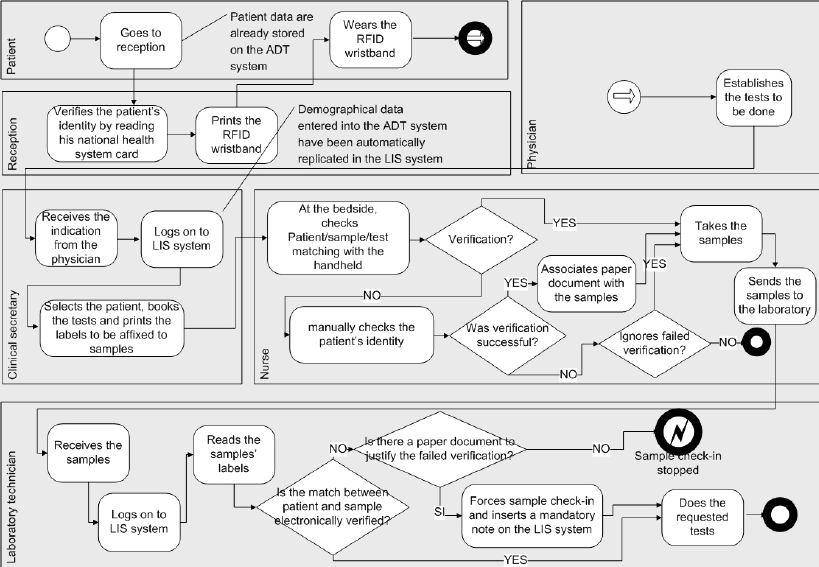

Solutions for hospital workflow optimization
Workflow analysis in healthcare is the key to providing competent and timely services to as many patients as possible. In this challenging time, hospital workflow processes require streamlining to eliminate management issues, staff errors, and prevent operational bottlenecks from occurring. Today, optimizing medical workflows is vital not only to address the consequences of the pandemic but to upgrade your facility.
Benefits of hospital workflow optimization
First of all, we should understand what a workflow analysis in healthcare is. At its core, the workflow is the orchestrated and repeatable healthcare activities that aim to deliver the best possible services with modern technologies. To streamline these, the medical facility should admit patients fast, coordinate clinicians' actions efficiently, cooperate with other medical centers, keep medical records and documentation up-to-date, and have the appropriate software for these purposes. Therefore, workflow optimization is an improvement for healthcare operations. According to HIPAA Journal, an efficient hospital workflow brings the following benefits to daily healthcare services:
1. Maximizes return on investment (ROI). The amount of return on a particular investment makes it clear if the facility matches the expectations. Disorganized workflow slows down the operational abilities of the hospital and doesn’t allow it to work at its full potential. Unhappy patients and doctors don’t achieve their objectives while ROI falls, and the facility loses its access to growth.
2. Retains valuable personnel. Brain drain exists in every segment of the economy and medicine is no exception. If talented doctors leave, the patients’ care quality goes down and newly-applied personnel lacks mentors to help them get on board. And they often leave because of burnout; redundant systems contribute to it. Workflow optimization addresses this challenge.
3. Improves healthcare overall. Outdated channels of communication hinder the delivery of prompt medical help. If hospitals don't communicate with each other and don't share EHR records, treatment results can be devastating. Therefore, clinical workflows in healthcare help to improve the whole system on every level.
4. Accelerates software development for the healthcare industry. If a medical facility can keep up-to-date, it should pursue the newest software, equipment, and skills. The development of software to operate patients' workflow and medical treatment is crucial for providing the best medical services.
Why processes around clinical practice need optimization?
To conduct workflow analysis in healthcare, you have to observe clinical practices and processes that surround them. According to MediFriendRx, the following challenges lower the quality of clinical practices:
Poor internal communication
For instance, in America data from people who have been transported to a hospital on ambulance often doesn't reach or reaches too long to patients' clinicians. Lab results are often lost or thought lost, which produces lots of doubles and overpayment. Often, after admission to the ER, patients wait for hours for a free doctor, free bed, or, in general, for someone to notice them—which is awful for their health outcomes and level of satisfaction with services. A centralized EHR system between all hospital departments is necessary to avoid all communication-related challenges. If your current EHR or software for records management system doesn't allow doing so, consider upgrading it or adopting new software — with automation, messaging, and other good stuff. We wrote an article on how good design for EHR will look like, check it out before making a decision.
Repetitive, not relevant tasks
Repetitive work and the administrative burden are associated with the legacy EHRs that are used in a hospital. Doctors spend a lot of time filling out forms in the EHR or trying to access patients' lab records. Another aspect of this challenge is nurses' hospital rounds: nurses often come to see patients who don't actually need help and assistance. To address it, hospitals can install patient monitoring systems and connect them to nurses' and clinicians' smartphones: in such a way, they would see patients if that's really required. That's especially vital in the pandemic: the risks of exposure are high. As for EHRs, a user-driven approach and friendly, pre-filled forms will be of assistance here.
Inadequate tools and/or lack of training
Software that overwhelms clinicians isn't a good fit for hospitals. It's been reported that doctors want to spend more time with patients, doing their job on diagnosis and treatment, not in front of the monitor. Some hospitals still use fax, and some still don't offer an online scheduling system that doctors can use to organize their time, and patients - to book an appointment. Lack of training in tech - lack of adoption process - often results in magnifying these challenges for both sides of the process and in additional complications like cybersecurity risks. So digital training is necessary. Keep in mind, that training should be included in the work hours and supervised by a person who is willing to make this process as easy and comfortable as possible.

Software solutions that help optimize workflow
The modern market provides plenty of solutions for healthcare software. Their utilization and application vary, yet the most promising are below:
1. PerfectServe. This cloud-based solution enables instant communication between physicians, nurses, and care team members. The company developed it to avoid clinicians’ burnout and related issues that make people quit or worsen health outcomes. Chime Central considers it the leading tool for team collaboration and clinical workflow optimization for US hospitals. Its practical use aims at preventing clinicians from losing information on patient’s data and prior procedures, optimizing shift schedules, and engaging patients to participate in their health management.
2. Siemens Healthineers. Siemens enables doctors to keep in touch with medical innovations through presentations, seminars, informative advertising, and practical training courses. With the help of SH, medical practitioners learn how to use the newest diagnostic tools, get software updates, and receive medical equipment. The company sets particular emphasis on cardiology systems.
3. Atrium Health, Carolina. The 2.8 million-square-foot campus implemented solutions for wayfinding and navigation for their patients. As timely attendance saves lives, 3,000 beacons function within the place to show the way for both new clinicians and patients. According to Julie Krohner, Chief Innovation Officer of Exit Design, mobile wayfinding will play just as significant a role within medical facilities as Google Maps do outside of them. Such tools not only help to find a way, but also to keep track of procedures, appointments, and treatment plans at Atrium Center. Patients are also happy with the implementation of new technology.
4. RFID hospital management. RFID-based solutions by Quake Global offer actionable data for clinical workflow analysis. Such software aims to spot and correct clinical inefficiencies, observe real-time operations and practices, mark outpatient satisfaction, and perform equipment management. While the tool offers a rather generalized approach to clinical workflow, its functions have a vast potential for future hospital systems that will rely on robotics.
Conclusion - solution for workflow optimization
Solutions for hospital workflow optimization, if adopted smoothly, help hospitals greatly. Streamlining the patient's care and EHRs makes the time between clinicians and patients shorter yet more meaningful. Clinical optimization enables better healthcare services as it prevents personnel burnout.
Among the main benefits of workflow optimization solutions are the communication improvement between medical teams, efficient data transferring between physicians, better training, and innovative medical software to provide smoother hospital operations.
In the end, the medical facility achieves its success only through the prevention of understaffing and overburdening in this pandemic-stricken time.
Tell us about your project
Fill out the form or contact us

Tell us about your project
Thank you
Your submission is received and we will contact you soon
Follow us
